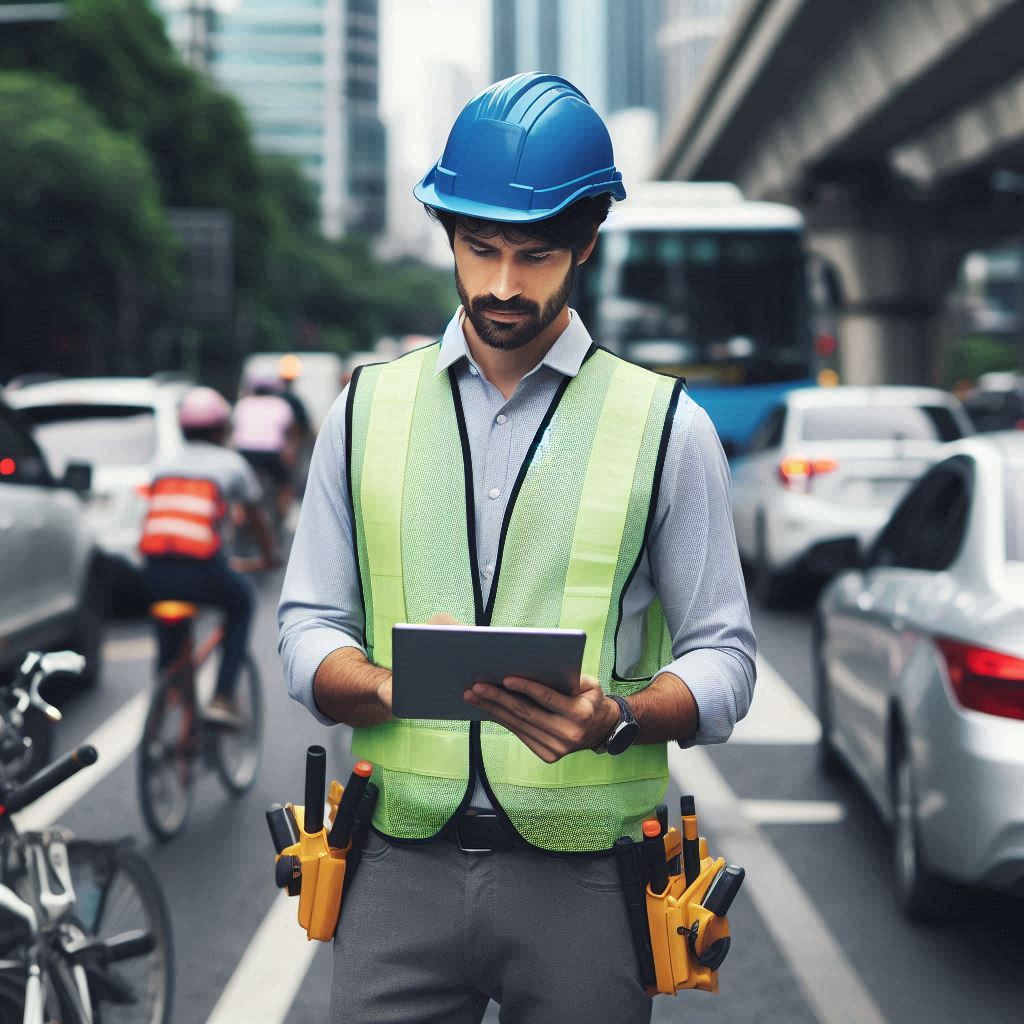Introduction
Geotechnical engineers play a critical role in the construction industry by analyzing soil and rock behavior to design stable and safe foundations.
They ensure that structures, from residential buildings to large infrastructure projects, can withstand environmental stresses and remain secure over time.
The primary responsibilities of geotechnical engineers include conducting site investigations, performing soil tests, and assessing ground conditions.
These activities provide essential data for making informed design decisions.
The importance of geotechnical engineers in construction projects cannot be overstated.
They are pivotal in preventing structural failures and mitigating risks associated with soil and rock variability.
By thoroughly evaluating subsurface conditions, geotechnical engineers help construction professionals select the most suitable construction methods and materials.
Their work ensures that foundations, retaining walls, and earthworks are designed to be robust and reliable.
In infrastructure projects such as bridges, roads, and tunnels, the expertise of geotechnical engineers is particularly vital.
They assess potential geotechnical hazards and provide solutions to ensure the longevity and safety of these structures.
For instance, in the construction of a bridge, geotechnical engineers analyze the soil and rock at the site to determine the best type of foundation.
They consider factors like load-bearing capacity and soil stability to ensure the bridge remains secure under various conditions.
Site investigation and analysis
Conducting Soil Tests to Determine Soil Properties
Geotechnical engineers play a crucial role in construction by conducting soil tests to determine soil properties.
These tests provide essential data about the soil’s composition, strength, and behavior under load.
Engineers collect soil samples from the construction site and analyze them in a laboratory.
Tests such as soil compaction, shear strength, and permeability are conducted to assess soil quality.
Understanding soil properties helps engineers design foundations that can safely support structures.
Accurate soil testing also informs the selection of appropriate construction materials and methods.
Engineers use test results to predict how soil will respond to environmental changes and loading conditions.
This information is vital for creating safe and durable structures.
Identifying Potential Risks such as Soil Instability or Groundwater Issues
Identifying potential risks is another critical aspect of a geotechnical engineer’s role.
Engineers assess soil stability to prevent problems such as landslides or settlement.
They evaluate factors like soil cohesion, compaction, and layering to predict stability issues.
Groundwater levels and flow patterns are also analyzed to identify potential risks.
High groundwater levels can lead to issues like soil liquefaction or foundation instability.
Engineers use this information to design drainage systems or implement ground improvement techniques to mitigate risks.
By anticipating these issues, engineers help avoid costly construction problems and enhance project safety.
Their proactive approach ensures that potential challenges are addressed before construction begins.
Basically, geotechnical engineers significantly impact construction through soil testing and risk identification.
Conducting thorough soil tests provides critical data on soil properties, guiding foundation design and material selection.
Identifying risks such as soil instability and groundwater issues helps engineers implement effective mitigation strategies.
Their work ensures the safety, stability, and success of construction projects, making geotechnical engineering a vital component of the construction process.
Foundation Design
Designing the Foundation Based on Soil Conditions and Structural Requirements
Geotechnical engineers play a crucial role in designing foundations that are both safe and effective.
They begin by assessing soil conditions through detailed site investigations.
Soil samples are analyzed to determine properties like compaction, density, and load-bearing capacity.
This information guides engineers in choosing appropriate foundation types, such as shallow or deep foundations.
The foundation design must account for soil behavior under different loads and environmental conditions.
Geotechnical engineers collaborate with structural engineers to integrate soil data with structural requirements.
This collaboration ensures that the foundation design supports the intended structure safely.
Properly designed foundations prevent issues like differential settlement and structural instability.
Engineers also consider factors such as groundwater levels and soil contamination in their designs.
Tailoring the foundation to specific soil conditions and structural needs enhances the overall safety and performance of the construction.
Ensuring the Foundation Can Support the Weight of the Building
Ensuring that the foundation can support the weight of the building is a critical responsibility of geotechnical engineers.
Engineers calculate the load-bearing capacity of the soil and compare it with the building’s weight.
They use this data to design a foundation that distributes loads evenly and efficiently.
Foundations must be strong enough to handle not only the building’s weight but also any additional loads from occupancy or environmental forces.
Geotechnical engineers employ various methods to enhance foundation strength, such as soil improvement techniques or using reinforced concrete.
They also conduct load tests to verify that the foundation performs as expected under real conditions.
This step ensures that the foundation can safely support the building throughout its lifespan.
By addressing load requirements and soil conditions, geotechnical engineers prevent structural failures and costly repairs.
Their expertise is vital in creating stable and durable foundations that meet safety standards.
Geotechnical engineers significantly impact construction by designing foundations based on soil conditions and structural requirements.
They analyze soil properties to ensure foundations support the building’s weight effectively.
Through precise calculations and tailored designs, they address load-bearing capacity and soil behavior.
Their work prevents structural issues and enhances the stability and safety of constructions.
By integrating soil data with engineering requirements, geotechnical engineers play a key role in successful and secure building projects.
Their expertise ensures that foundations are robust and capable of supporting various structural loads, contributing to the overall integrity of construction.
Slope stability analysis
Assessing the Stability of Slopes to Prevent Landslides or Slope Failures
Geotechnical engineers play a critical role in assessing slope stability to prevent landslides and slope failures.
They conduct detailed site investigations to understand soil and rock properties.
Engineers use techniques like slope stability analysis to evaluate potential risks.
This analysis involves studying factors such as soil composition, groundwater conditions, and slope geometry.
They apply various methods, including computational modeling and field tests, to predict how slopes will behave under different conditions.
Engineers analyze data to identify weak spots and potential failure zones.
They assess the impact of environmental factors, such as rainfall and seismic activity, on slope stability.
By understanding these factors, engineers can anticipate how slopes may shift or fail.
They use this information to design effective stabilization solutions.
Proper assessment helps in designing structures that can withstand the forces acting on them.
Recommending Proper Measures to Reduce Risks
Once engineers assess slope stability, they recommend measures to mitigate risks and enhance safety.
One common approach is to implement slope stabilization techniques.
These may include retaining walls, soil nails, or ground anchors.
Retaining walls provide structural support to hold soil in place, while soil nails reinforce weak slopes.
Ground anchors stabilize slopes by securing them to deeper, more stable soil layers.
Engineers also suggest drainage solutions to manage water flow and reduce soil saturation.
Proper drainage prevents water from accumulating in slopes, which can weaken soil and increase the risk of failure.
Engineers may design systems such as surface drains, subsurface drains, or permeable materials to facilitate effective water management.
In some cases, engineers recommend regrading slopes to reduce their steepness.
Gentle slopes are less likely to fail than steep ones.
Regrading involves reshaping the slope to create a more stable angle, thus reducing the likelihood of landslides.
Another measure is the use of vegetation to stabilize slopes.
Plant roots help bind soil particles together and absorb excess water.
Engineers may recommend planting grasses, shrubs, or trees to enhance slope stability and promote erosion control.
Engineers also conduct regular monitoring and maintenance of slopes.
They install instrumentation to measure ground movements and detect early signs of instability.
Continuous monitoring allows engineers to identify and address potential issues before they escalate into serious problems.
Read: Sustainable Wastewater Treatment Methods
Earthquake Engineering
Designing Structures to Withstand Seismic Activities
Geotechnical engineers play a crucial role in designing structures to withstand seismic activities.
They assess soil conditions and seismic risks at construction sites.
This analysis informs the design of foundations that can absorb and dissipate seismic energy.
Engineers use techniques like soil-structure interaction studies to ensure structures remain stable during earthquakes.
They incorporate flexible materials and base isolators in designs to minimize the impact of ground shaking.
By understanding local seismic activity and soil behavior, engineers create structures that can better endure seismic forces.
Their expertise helps prevent structural damage and protect lives during earthquakes.
Implementing Seismic Retrofitting Techniques to Improve Building Resilience
Seismic retrofitting is essential for enhancing the resilience of existing buildings.
Geotechnical engineers apply various retrofitting techniques to strengthen structures and improve their earthquake performance.
One common method is adding base isolators, which absorb seismic energy and reduce shaking transmitted to the building.
Engineers also reinforce foundations and structural elements to enhance stability.
They may install steel braces or shear walls to improve lateral resistance.
Strengthening connections between building components ensures better overall stability.
By applying these techniques, engineers extend the lifespan of older buildings and ensure they meet current seismic standards.
Effective retrofitting helps safeguard buildings against future seismic events.
Geotechnical engineers significantly impact construction through their expertise in designing structures to withstand seismic activities and implementing retrofitting techniques.
Their role in assessing soil conditions and seismic risks informs the creation of earthquake-resistant foundations and structures.
By incorporating flexible materials and advanced design techniques, engineers ensure buildings can absorb seismic energy effectively.
Seismic retrofitting further enhances the resilience of existing structures, protecting them from future earthquakes.
Through these practices, geotechnical engineers contribute to safer and more durable buildings, improving overall construction quality and disaster preparedness.
Their work ensures that structures can withstand seismic challenges and safeguard both people and property.
Read: Tips for Writing Environmental Engineering Reports
Construction quality control
Monitoring Construction Activities to Ensure Compliance with Geotechnical Recommendations
Geotechnical engineers significantly influence construction projects through rigorous monitoring of construction activities.
Their primary role is to ensure that construction aligns with geotechnical recommendations.
Engineers review construction plans and specifications to identify critical geotechnical requirements.
They monitor excavation work to confirm that it adheres to design parameters and safety standards.
During construction, engineers assess soil and rock conditions to verify that they match initial assessments.
Engineers also supervise the installation of geotechnical instrumentation, such as inclinometers and piezometers.
These instruments measure ground movements and groundwater levels, providing real-time data.
Regular monitoring helps detect deviations from expected conditions, allowing for timely adjustments.
Engineers ensure that construction methods, like piling or soil stabilization, follow approved procedures.
Their oversight prevents issues such as foundation settlement or slope instability, which could compromise the project’s integrity.
Geotechnical engineers collaborate with construction teams to address any emerging issues.
They interpret data from field instruments and provide guidance on necessary modifications.
Engineers also verify that any changes in construction methods still meet geotechnical recommendations.
By maintaining close communication with project managers and contractors, they help resolve problems efficiently.
Their proactive monitoring reduces the risk of structural failures and ensures project safety.
Conducting Field Inspections to Verify Proper Implementation of Design Specifications
Field inspections are a critical component of a geotechnical engineer’s responsibilities.
These inspections verify that construction practices align with design specifications.
Engineers conduct site visits to review construction activities and assess compliance with engineering plans.
They inspect soil compaction, foundation installation, and other geotechnical aspects to ensure they meet project requirements.
During field inspections, engineers test soil properties and material quality.
They check for consistency with laboratory test results and design specifications.
Engineers also evaluate the performance of geotechnical systems, such as retaining walls and drainage systems, to confirm their effectiveness.
Their inspections help identify any discrepancies between the design and actual construction.
Engineers document their findings and report any issues to project managers.
They recommend corrective actions to address any non-compliance or deficiencies.
Regular inspections and prompt reporting help maintain construction quality and prevent costly rework.
Engineers also review the implementation of safety measures to protect workers and the public.
Read: Environmental Engineers in the Mining Industry

Environmental impact assessment
Evaluating the Environmental Impact of Construction Activities on Soil and Groundwater
Geotechnical engineers play a critical role in evaluating the environmental impact of construction activities on soil and groundwater.
They assess how construction projects affect soil stability and groundwater quality.
Engineers conduct site investigations to understand soil properties and identify potential contamination risks.
They use advanced testing methods to analyze soil composition and groundwater levels.
Evaluating the impact involves studying how construction activities, such as excavation and piling, may alter soil structure and affect groundwater flow.
Engineers also monitor potential contamination from construction materials and machinery.
By assessing these factors, geotechnical engineers provide essential insights into environmental risks associated with construction.
Suggesting Mitigation Measures to Minimize Negative Effects on the Environment
Geotechnical engineers recommend mitigation measures to minimize the environmental impact of construction projects.
They propose solutions to address soil erosion and sediment control.
For instance, installing silt fences and sediment traps helps prevent soil from washing into waterways.
Engineers also suggest measures to manage groundwater, such as dewatering systems and groundwater monitoring.
They advise on using environmentally friendly materials and techniques to reduce contamination risks.
Implementing proper waste disposal methods and reducing the use of hazardous substances are additional strategies.
Engineers recommend practices to restore disturbed areas, such as replanting vegetation and stabilizing soil.
By suggesting these measures, geotechnical engineers help minimize negative environmental effects and ensure sustainable construction practices.
Geotechnical engineers significantly impact construction by evaluating and mitigating environmental effects on soil and groundwater.
They assess how construction activities alter soil stability and groundwater quality.
By conducting thorough site investigations and monitoring potential contamination, engineers identify environmental risks early.
They recommend various mitigation measures, such as erosion control, groundwater management, and sustainable material use.
Implementing these measures helps minimize environmental impact and promotes responsible construction practices.
Through their expertise, geotechnical engineers contribute to safer, more sustainable construction projects that protect natural resources and support long-term environmental health.
Read: Environmental Engineering Software and Tools
Risk management
Identifying Potential Risks Related to Soil and Geological Conditions
Geotechnical engineers play a crucial role in construction by identifying risks related to soil and geological conditions.
They conduct site investigations to assess soil properties, such as strength, compressibility, and permeability.
Engineers analyze soil samples and geological surveys to understand subsurface conditions.
They use this data to identify potential risks, such as soil liquefaction, slope instability, and foundation settlement.
Recognizing these risks early helps prevent costly issues and ensures the safety of construction projects.
Engineers also evaluate the impact of nearby structures and natural features on soil stability.
This comprehensive analysis allows them to anticipate and address problems before construction begins.
Providing Recommendations to Mitigate Risks and Ensure Project Safety
Once potential risks are identified, geotechnical engineers provide recommendations to mitigate these risks and ensure project safety.
They design appropriate foundation systems based on soil conditions, such as deep foundations or soil improvement techniques.
Engineers may recommend ground improvement methods, such as compaction grouting or soil stabilization, to enhance soil strength.
They also advise on proper drainage solutions to prevent water accumulation, which can weaken soil and lead to instability.
For projects on unstable slopes, engineers suggest methods like retaining walls or slope reinforcement to maintain soil stability.
Engineers collaborate with architects and construction teams to integrate geotechnical recommendations into the overall project design.
They provide guidance on construction techniques that minimize risks and enhance safety.
For example, they might recommend specific excavation methods or construction sequencing to reduce the impact on soil stability.
Engineers also oversee the implementation of their recommendations during construction to ensure compliance with safety standards.
Monitoring and ongoing assessment are also part of the risk mitigation process.
Geotechnical engineers implement instrumentation and monitoring systems to track changes in soil conditions during and after construction.
They analyze data from these systems to identify any emerging issues and recommend corrective actions if needed.
Regular inspections and assessments help address potential problems before they escalate, ensuring the continued safety and stability of the construction project.
Transform Your Career Today
Unlock a personalized career strategy that drives real results. Get tailored advice and a roadmap designed just for you.
Start NowCollaboration with other professionals
Working Closely with Architects, Structural Engineers, and Contractors
Geotechnical engineers play a vital role in construction projects by collaborating closely with architects, structural engineers, and contractors.
They provide essential insights into soil conditions and ground stability, which inform design and construction decisions.
By sharing their expertise, geotechnical engineers help architects develop designs that accommodate the site’s unique challenges.
Their input ensures that structures are built on a solid foundation, reducing risks of settlement or failure.
Structural engineers rely on geotechnical data to design safe and effective load-bearing structures.
Geotechnical engineers analyze soil tests and provide recommendations for foundation types and construction methods.
This collaboration ensures that structures can support intended loads and withstand environmental stresses.
Contractors benefit from geotechnical engineers’ advice on excavation, soil treatment, and site preparation, leading to smoother construction processes and fewer unexpected issues.
Participating in Interdisciplinary Teams
Geotechnical engineers are integral members of interdisciplinary teams that approach construction projects holistically.
They work alongside environmental engineers, hydrologists, and urban planners to address various aspects of a project.
This team approach ensures that all potential impacts, from soil erosion to groundwater management, are considered.
In interdisciplinary teams, geotechnical engineers contribute to comprehensive planning by providing critical information on ground conditions and their implications.
Their expertise helps identify potential geohazards and environmental concerns early in the design phase.
Collaborating with environmental engineers, they address issues such as soil contamination and groundwater impacts, ensuring projects meet regulatory requirements and sustainability goals.
Geotechnical engineers also coordinate with urban planners to integrate construction projects into existing infrastructure and landscapes effectively.
They help assess the impact of new developments on surrounding areas and recommend solutions to mitigate any negative effects.
This holistic approach leads to well-planned projects that fit seamlessly into their environments and communities.
Conclusion
Geotechnical engineers have a profound impact on construction projects, starting with analyzing soil conditions and designing stable foundations.
Their expertise ensures structures can withstand environmental challenges like earthquakes, floods, and soil erosion.
By identifying potential site issues early, they prevent costly and dangerous failures that could compromise the entire project.
Their role is crucial in assessing risks related to soil, rock, and groundwater.
Geotechnical engineers conduct detailed site investigations, providing vital data that help tailor construction plans to specific site conditions.
This proactive approach minimizes unforeseen complications, supporting efficient and timely project execution.
Their assessments guide the design and implementation of foundations, retaining walls, tunnels, and other critical infrastructure components.
Geotechnical engineers also play a significant role in sustainable construction practices.
They incorporate eco-friendly materials and methods, such as recycled aggregates and bio-based solutions, enhancing the long-term viability of projects.
By focusing on reducing environmental impact, they help create structures that are not only stable but also environmentally responsible.
Furthermore, geotechnical engineers contribute to improving construction safety.
Their detailed analysis and recommendations ensure that construction methods and materials are suitable for the site conditions, thereby reducing the risk of structural failures.
This attention to detail protects both the construction workforce and future occupants of the building.
[E-Books for Sale]
The Big Book of 500 High-Paying Jobs in America: Unlock Your Earning Potential
$19.99 • 500 High-Paying Jobs • 330 pages
Explore 500 high-paying jobs in America and learn how to boost your career, earn more, and achieve success!
See All 500 High-Paying Jobs of this E-Book
1001 Professions Without a Degree: High-Paying American Jobs You Can Start Now
$19.99 • 1001 Professions Without a Degree • 174 pages
Discover 1001 high-paying jobs without a degree! Unlock career tips, skills, and success strategies for just $19.99!




